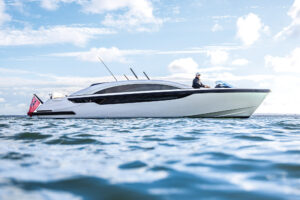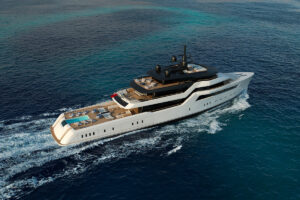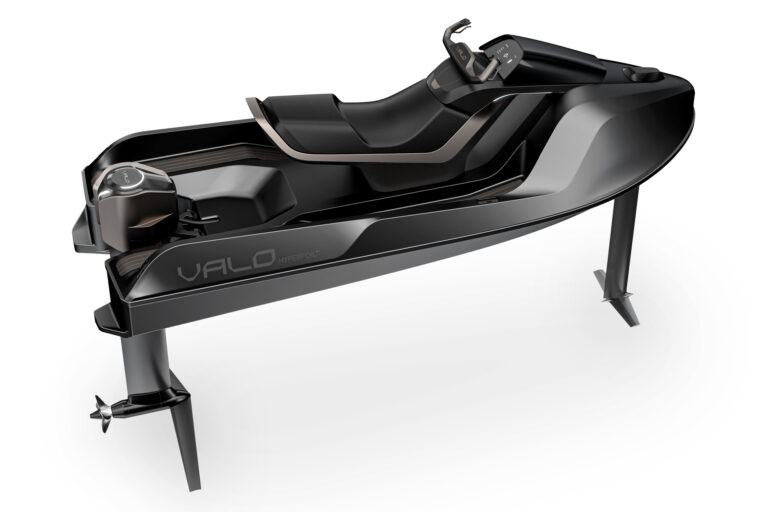A day at the helm of Pamina is beyond sailing. Sailing is what you do on your day boat or one-design. Being aboard Pamina is an event, exactly what the experience should be aboard an extraordinary yacht.
Conceived by her owner, Bernie Gustin, drawn by Ted Fontaine of the Ted Hood Yacht Design Group and built in Holland by Royal Huisman, _Pamina_is named for the heroine in Mozart’s opera “The Magic Flute.” She’s the daughter of the Queen of the Night, magically beautiful and always truthful, as is her namesake yacht. This boat is big, superbly finished inside and out, insanely comfortable belowdecks and a joy to drive. Her design is a timeless blend of traditional lines above the water and modern thinking below. Although she’s smaller than a J-Class yacht from the 1930s, she is nearly equal in style and impact, even to casual observers.
Like the J-Class yachts, she carries a huge cloud of sail, though Pamina’s are North Spectra, rather than canvas, set on Rondal carbon-fiber spars. A robust hydraulic boom furling system makes child’s play of managing the massive main. Although boom furlers have grown in popularity, this one differs from others I’ve experienced. The furling mandrel carries none of the loads produced by the foot of the sail. Instead, the tack and clew attach directly to fittings on the mast and boom after the sail reaches full hoist (and at each of its three reef points), all of which happens automatically as though directed by Disney. Operation is nearly silent. Both headsails set, reef and stow on Rondal hydraulic furling gear. Sail trimming duty goes to giant Rondal captive-reel winches beneath the side decks on either side of the forward cockpit. A crew of two can easily sail Pamina, but the complexity of her many systems requires at least an engineer for long passages.
Most yachts of this stature result from a symbiosis between knowledgeable client and talented designer. Gustin and Fontaine have known each other for years and have worked together on other yachts, laying the groundwork for this one.
Gustin wanted a yacht in which he and his family could waltz with icebergs in the high latitudes or swim with manta rays in the great South Pacific. This is one reason she’s so big. Size has a lot to do with a boat’s ability to handle rough seas with safety and to coddle her crew and passengers with a comfortable motion. _Pamina_is 112 feet LOA and displaces 140 tons, so she heels slowly in the gusts, rises and falls gracefully in the swells and shoulders through crests without so much as a “Thank you, ma’am.” Her high freeboard keeps her decks dry in all but the nastiest seas, and the pilothouse shelters her crew from inclemency outdoors.
For all her grace under fire, _Pamina_is definitely not a slouch. Gustin didn’t want her to be as fast as a Vendeé Globe Open 60, but he needed a good turn of speed under sail, say 10 to 12 knots average in cruising conditions. Many yachts this length and displacement aren’t very entertaining from the helm. _Pamina_differs in this respect. Although she changes direction deliberately, she answers the captain’s requests with a genteel pressure on the steering wheels, the way a Victorian lady of substance would grasp your hand in greeting. She tacks reliably, if a bit slowly, and on the new tack gathers speed at a leisurely pace, the way a 1930s Packard V-12 touring car would torque from a snail’s pace into top gear.
Big, heavy boats need a lot of wind to show their livelier side, and _Pamina_is no different. I didn’t get to meet that side because I sailed her in winds of 10 to 12 knots on Narragansett Bay. She ghosted along nicely at 8 knots on a beam reach, heeling a few degrees and ignoring the light bay chop. Like so many modern cruising yachts, _Pamina_is really a motorsailer. If the wind dies, as it often does on passages and day sails, her 415 horsepower MTU engine will drive her quietly at hull speed. She carries enough fuel to remove any doubt about making port; her range under power is about 3,000 nautical miles at an 11-knot cruise.
I boarded _Pamina_a short launch ride off Harbour Court, the New York Yacht Club’s Newport, Rhode Island, home. We motored to a quiet anchorage on the back side of Prudence Island, putting ourselves out of sight of the Portsmouth boat yards, to have lunch. Anchoring, too, is theater. The anchors deploy on a trolley. When the crew pushes a remote control button, the trolley moves forward, extending the anchor well beyond the bow before it descends into the water. The helmsman can operate the system from the wheel.
Curtain down on that act, we joined the guests for lunch. The pilothouse is all windows and provides an excellent 360-degree view. Gustin wanted everyone seated at the C-shape dinette to have a grand view of the outdoors, so the area is about a foot higher than the pilothouse sole. The dining tables raise, lower and swivel into a variety of configurations. Aboard for our luncheon were Gustin, his mother and son, Fontaine and a family friend. We fit comfortably around the tables, which were arranged in an L-shape. The navigation station is opposite the dinette.
Royal Huisman built _Pamina_from Alustar aluminum alloy, a relatively new alloy that is 25 percent stronger and more corrosion-resistant than previous alloys. Aluminum boats can be noisy, so the entire interior floats on resilient isolators to prevent outside vibrations from disturbing folks inside and to prevent machinery vibrations from resonating off the aluminum hull. The system makes _Pamina_whisper-quiet when she motors.
As appealing as her pilothouse saloon is, my favorite spots are the lounge right forward of the house and down a few steps, and the master stateroom all the way aft. The exquisite teak joinery and blue fabrics of the lounge create a cozy setting for watching a video, reading, dining or napping, especially on dreary days. The day head is right forward of the settee on the starboard side.
I wanted to move permanently into the master suite the moment I set foot on its sole. Although the space is deep in the hull, large portlights flood it with natural light. I imagined myself seated at the curved desk to port, writing my next destination feature from an exotic anchorage. I’d be just as happy propped on the curved lounge right aft, sipping single-malt Scotch and listening to Miles Davis. A companionway next to the berth leads to a private after cockpit, which is inviting for coffee and a sunrise.
A pair of guest staterooms fill the space between the master and the engineroom. Crew’s quarters are all the way forward, along with the galley, which spans the entire beam and has food preparation on the starboard side, clean-up and disposal to port. The accommodations are ideal for charter, if Gustin decides to place her in service.
Contact: Ted Hood Design Group, (401) 683-7003; fax (401) 683-7251; www.thco.com. Royal Huisman Shipyard, (207) 646-9504; fax (207) 646-9687; www.royalhuisman.com.








